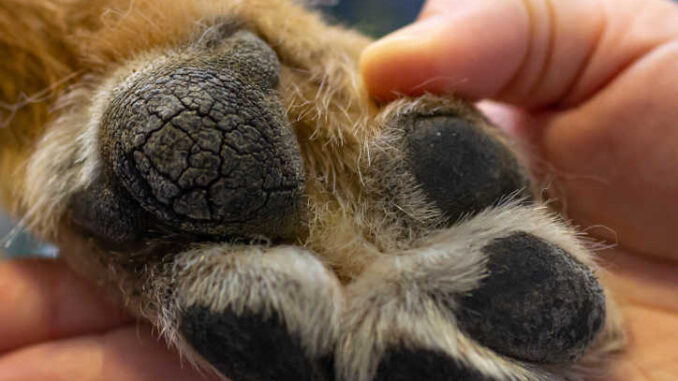
This article was updated on May 2nd, 2023
A dog’s feet often seem indestructible. After all, they’re on the go in all types of terrain, allowing your dog to keep up with you wherever you go. But the truth is, a dog’s feet aren’t indestructible. They can actually be very vulnerable to injuries and cracks in the foot pads. Cracked paws are not uncommon, especially in cold weather.
If your pup is unfortunately experiencing cracked paws, we’re here to help you identify what’s causing it and how you can help make them comfortable so that your dog can maintain their mobility and their place as your shadow.
What Can Cause Your Dog’s Paws to Crack?
Cracked dog paws are no fun since they can affect your dog’s ability to get around, making both you and your dog sad. Often the first step in helping them is finding out what is causing their paws to crack. With this in mind, here are some common causes of cracked paws in dogs.
1. Too Cold
Winter presents many challenges to all parts of a dog’s body. While some may enjoy a romp in the snow, that cold can suck the moisture from your dog’s footpads, causing them to dry out and crack. Snow and ice can also pack in between their toes, causing irritation and increased licking and chewing. Ice remover chemicals, including salt, is another irritate and drying agent that plays a part in causing cracked dog paws.
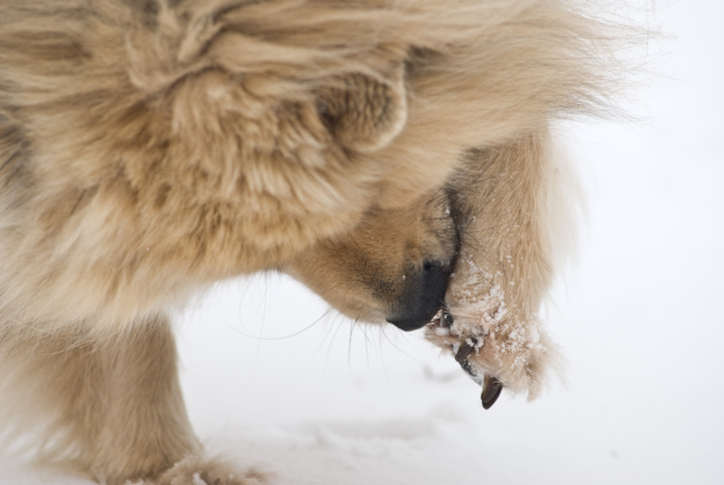
2. Too Hot
Winter isn’t the only time you need to keep an eye on your dog’s feet. Summer presents its own form of issues. Hot sidewalks, sand, and pavement can burn a dog’s feet leading to blisters and cracks. The hot surfaces can also draw moisture from their skin, leading to dry cracking. And, if you have a dog with light colored footpads, sunburn may be an issue as well.
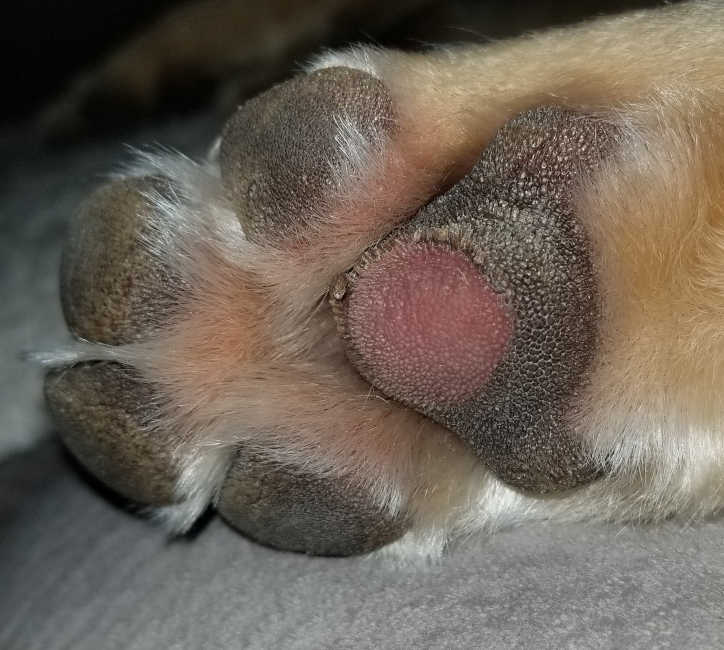
3. Too Rough
Hiking with your pup is a great way to spend time with them and connect with nature, but it can wreck all kinds of havoc on their paws. Rocks, dirt, sand, and wood are all capable causing abrasions and blisters that can lead to cracking.
Along with rough surfaces, grass seeds can also become lodged in pads or between toes causing injuries including cracking.
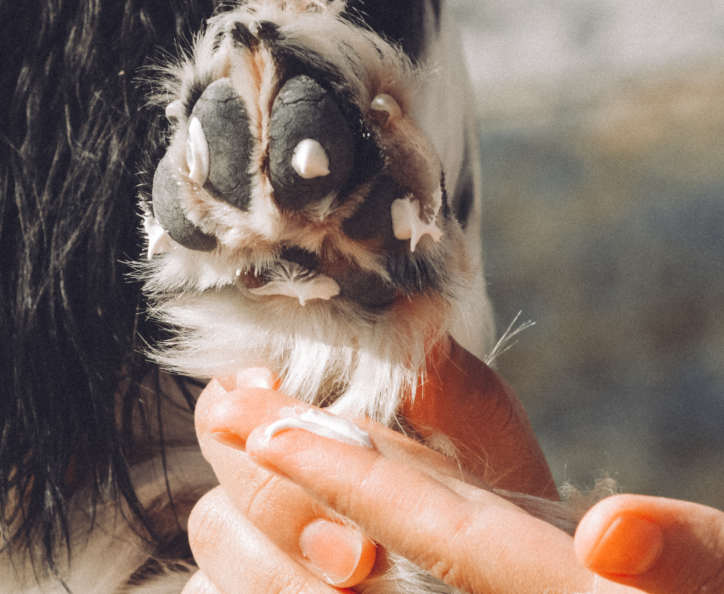
4. Too Wet
Swimming is a nearly perfect exercise for dogs that love water. However, pools that contain chlorine and salt water can dry out dog paws, leaving painful cracks in their wake.
Another form of moisture that is actually drying is excessive licking. Some dogs lick their paws because they’re itchy from allergies, irritations, or injuries. Others lick their paws as a nervous habit. To make things worse, a dog may lick their feet because their paws are cracked. It’s a vicious cycle that could lead to an infection.
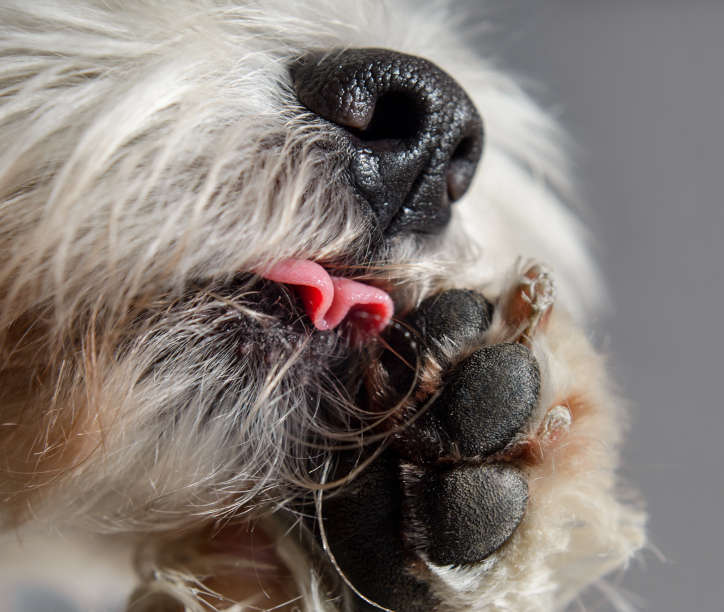
Keep an eye on dogs that have other allergy signs, including itchy, red skin, or ear infections. Also, certain breeds are more susceptible to developing allergies that could cause licking and cracked paws. Cocker Spaniels, Poodles, Beagles, Golden Retrievers, Labs, Shar Peis, and West Highland Terriers.
5. Too Little Zinc
Some dogs may suffer from zinc deficiency, a major issue for a dog’s skin. Not only will dogs with zinc deficiency have cracked paws, they may also have crusts and scales around their eyes, nose, and mouth and a dull, dry haircoat. Breeds that are more likely to get have zinc deficiency include Great Danes, Labs, Huskies, Dobermans, and German Shepherds.
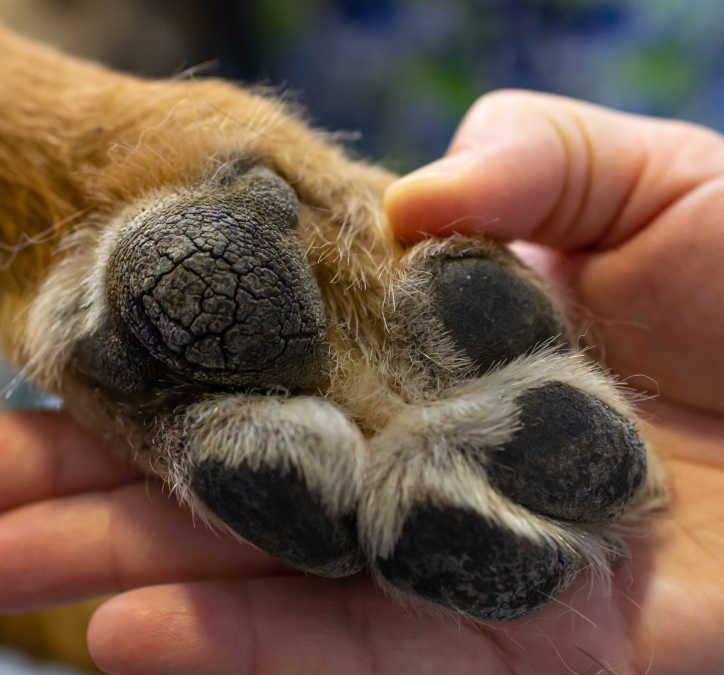
Are Cracked Dog Paws a Cause for Concern?
Just noticing a few shallow cracks in your dog’s paws doesn’t always mean you need to take immediate action. Some dogs may just naturally have dryer skin than others and a few mild cracks may be commonplace for them. Dogs that spend a lot of time outdoors may actually have thicker foot pads than most, so some shallow cracks may be normal for them without causing much of an issue.
When you need to worry about their feet is when those cracks are numerous or especially deep. Cracked paws start to get sore as well. Any limping, bleeding, or peeling of the footpad should be looked at. Also, watch out for redness and swelling, or excessive licking. You won’t always catch your dog in the act of licking, but brown staining on light colored fur is a tell-tale sign that your dog has been showing their feet a little extra attention with their tongue.
3 Steps You Can Take at Home to Help Your Dog with Cracked Paws
If your pup is at all bothered by cracked paws and are showing any of the above signs, here are some ways to help.
1. Clean Them
Gently washing your dog’s feet in warm water and a mild soap can help remove any irritants or foreign objects that could be causing problems. Be sure to dry them completely, including between the toes, since we know that excessive moisture may actually make the problem worse.
2. Moisturize Them
Once the paw is clean and dry, try rubbing some vitamin E or dog foot balm into the affected pads to help moisturize and protect the paw. Be sure to use a non-toxic option since your dog will more than likely try to lick it off.
3. Protect Them
When you have your dog’s paws on their way to healing, you’ll want to be sure to protect them to prevent future problems. Apply a petroleum-based product or balm, such as Vaseline, to their paws before going outside in the winter or slip on some warm dog booties. A set of grippy hiking boots may also be a good idea for dogs that spend a lot of time on the trail. Avoid hot surfaces and rinse your dog’s feet when they come inside
Best Products for Cracked Dog Paws
You’re going to find a lot of products out there that are geared toward helping a dog with cracked paws. Here are a few favorites to help you weed through them.
1. Musher’s Secret
This product serves as a both a treatment and a protectant for dog paws in any weather. It completely safe and non-toxic and it absorbs quickly into foot pads so that your pup doesn’t have to wait to go outside and play. It works great for cold, heat, and rough terrain.
Some dogs may have allergic reactions to this product, so be sure to monitor your dog’s feet carefully after the first use. Watch for signs of redness, swelling, or itchy feet.
2. Vets Preferred Paw Balm
Another great treatment and protectant is Vets Preferred Paw Balm. It is non-toxic and quick to absorb. It will soothe cracked paws and protect them from heat, cold, and roughness. This balm may stand up for multiple days of use as well.
Just watch out for allergic reactions, especially if a dog is prone to allergies. Redness, swelling, or itchiness may occur with use.
3. Natural Dog Company PAWDICURE Bundle
For a more natural and organic approach, try this bundle from Natural Dog Company. The bundle contains both a paw soother and paw protectant. The stick form makes it easy to apply and you won’t get your fingers greasy in the process.
These products may take a little longer to absorb so dogs have more of a chance to lick them off and there’s more chance for them to get on your carpets.
4. Ruff Wear Everyday Dog Boots
If your dog experiences constant cracked paws no matter how many ointments you try, protective booties might be the way to go. These boots are a good all-around boot that can be worn in the heat, snow, or hiking. Dogs that spend a lot of time in any of these conditions may need a more specialized boot, but this works for most mild to moderate users.
Dog boots can be hard to get on and hard to keep on, so be sure to measure your dog’s foot carefully and get the proper size.
How Does a Vet Treat Cracked Dog Paws?
For chronic cracked paws or severe ones that also have bleeding, swelling, or lameness, see your veterinarian. These conditions may mean that your dog’s cracked paws are due to something more serious than just environmental irritations.
Your vet will thoroughly check your dog’s feet and may check other areas of the body for signs of allergies or nutritional deficiencies. In some cases, allergy testing or bloodwork may be needed.
Vet Treatment
For dogs with cracked paws due to weather or terrain, your vet may recommend or prescribe you a paw ointment or balm. They may also provide you with an e-collar to keep nosy tongues away, and they may provide anti-inflammatories or pain medications to make your pup a little more comfortable.
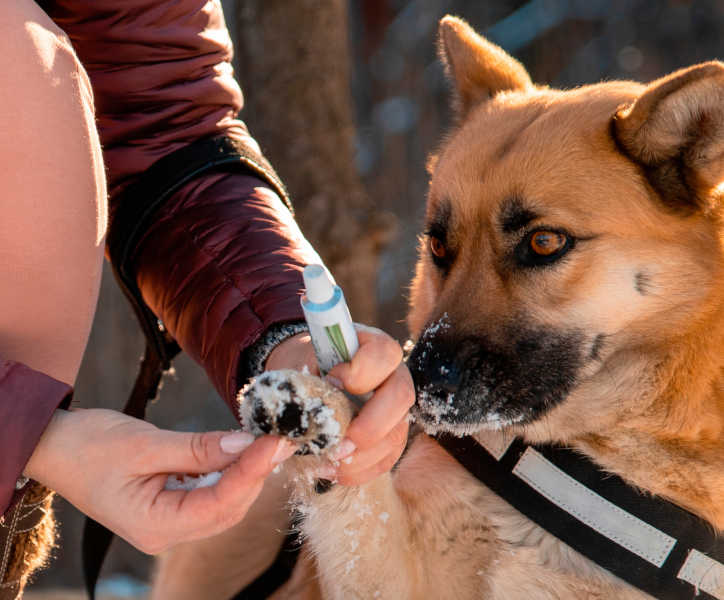
Dogs with allergies will need to be treated with topical or oral antihistamines or anti-inflammatories. They may also recommend medicated shampoos to better clean your dog’s feet.
Nutritional deficiencies will need to be treated with the proper supplement.
Cracked paws have a good prognosis, especially if you can get a proper paw protectant that will heal and prevent future problems.
Cost
Most cases of cracked dog paws are going to include a vet visit plus any medications. Look to pay $50-$100. If your pup is suffering from allergies or other health conditions, that number could increase to $250-$400 for additional testing and treatments.
What You Should Know Before a Vet Visit
If you know what’s causing your dog’s paws to crack, be sure to let the vet know. Tell them that they’ve been out in the snow or walked across some ice melt, or that your dog loves to run on the hot, sandy beach. That will help your vet decide if further tests are needed.
Keep track of how long your pup has had a problem and any treatments that you have tried so your vet will know where to go next.
Recovery Expectations for Dogs with Cracked Paws
Even the most potent paw balm is going to take a little while to work. Don’t expect overnight success. Cracked paws can take a couple of weeks to fully heal, especially if those cracks are deep and causing other signs.
Dogs with allergies will take some time as well. Allergies can be tough to pin down and control, so expect some trial and error of medications and treatments until you find one that gives your pup some good results.
Cracked Dog Paws FAQs with the Vet
What should I do if my dog has cracked paws?
If your dog’s cracked paws are mild and they’re not showing any signs of bleeding, lameness, or swelling, you may choose to rub some vitamin E or paw balm on them and allow them time to heal. If the cracks are severe and they have other signs, see your vet.
Are cracked paws painful to dogs?
Some mild cracks may not be painful, especially if a dog has built up a tolerance for cold and heat and has thicker foot pads. Deep or multiple cracks can be very painful and cause bleeding, lameness, and swelling.
What can you put on a dog’s cracked paw?
There are many commercial paw balm products available that are effective and safe to use. However, in a pinch, you can also use petroleum-based balms, such as Vaseline, or a vitamin E rub.
How long does it take for cracked paws to heal?
It can take a couple of weeks for cracked paws to completely heal, especially if there were multiple or deep cracks. It may take longer for cracked paws to heal if they are due to allergies or nutrient deficiencies.
What is a natural antiseptic for cracked paws?
Cracked paws can be cleaned with warm water and a mild soap. Harsher soaps and disinfectants can actually make the problem worse, so stick with a mild hand or dish soap and be sure to rinse it thoroughly.
Can I put Neosporin or Vaseline on my dog’s cracked paws?
Neosporin and Vaseline can be used on cracked dog paws in a pinch. Just make sure to keep your dog from licking until the product has absorbed thoroughly.
Related posts about paw issues:
 Dog Paw Allergy Issues: 6 Tips to Help Your Dog [With Pictures] - One of my pet parents brought her dog into the clinic because he was furiously licking and chewing on his… [...]
Dog Paw Allergy Issues: 6 Tips to Help Your Dog [With Pictures] - One of my pet parents brought her dog into the clinic because he was furiously licking and chewing on his… [...] White Bumps on a Dog’s Paw: Most Likely Reasons - If you’ve noticed a new white bump or lump on your dog’s paw you’re probably wondering what’s causing it. White… [...]
White Bumps on a Dog’s Paw: Most Likely Reasons - If you’ve noticed a new white bump or lump on your dog’s paw you’re probably wondering what’s causing it. White… [...]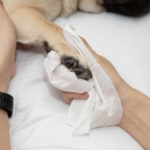 4 Cysts Often Found on Dog Paws [With Pictures & Vet Advice] - Ahh dog feet, giant Great Dane Marmaduke paws, tiny terrier tootsies, the puffy, fluffy white feet of a Bichon Frisé.… [...]
4 Cysts Often Found on Dog Paws [With Pictures & Vet Advice] - Ahh dog feet, giant Great Dane Marmaduke paws, tiny terrier tootsies, the puffy, fluffy white feet of a Bichon Frisé.… [...] Paw Yeast Infections in Dogs: What They Look Like & What To Do - When most people think of yeast, the first thing to come to mind would probably be a freshly baked loaf… [...]
Paw Yeast Infections in Dogs: What They Look Like & What To Do - When most people think of yeast, the first thing to come to mind would probably be a freshly baked loaf… [...]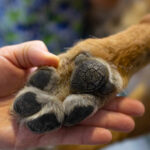 Paw Problems: 8 Common Lumps on Dog Paws [16 Pictures] - Seeing skin issues is a nearly everyday thing at our veterinary clinic. This article will help you identify lumps, bumps,… [...]
Paw Problems: 8 Common Lumps on Dog Paws [16 Pictures] - Seeing skin issues is a nearly everyday thing at our veterinary clinic. This article will help you identify lumps, bumps,… [...]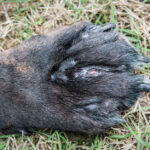 Dog with Swollen Paws [with Pictures] Our Veterinarian Explains What to Do - A dog with swollen paws or paw pads may be suffering from something as simple as a thorn in their… [...]
Dog with Swollen Paws [with Pictures] Our Veterinarian Explains What to Do - A dog with swollen paws or paw pads may be suffering from something as simple as a thorn in their… [...]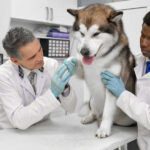 Dog Paw Infections and Issues: Pictures & Vet Advice - Dog paw infections are one of the more common issues that we treat in our veterinary hospital: dogs often excessively… [...]
Dog Paw Infections and Issues: Pictures & Vet Advice - Dog paw infections are one of the more common issues that we treat in our veterinary hospital: dogs often excessively… [...] Why Is My Dog Constantly Licking His Paws? Veterinarian Advice - You may notice your dog licking his paws on occasion. This is often just part of his everyday grooming routine;… [...]
Why Is My Dog Constantly Licking His Paws? Veterinarian Advice - You may notice your dog licking his paws on occasion. This is often just part of his everyday grooming routine;… [...]Disclaimer: This website's content is not a substitute for veterinary care. Always consult with your veterinarian for healthcare decisions. Read More.


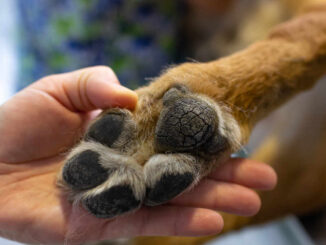
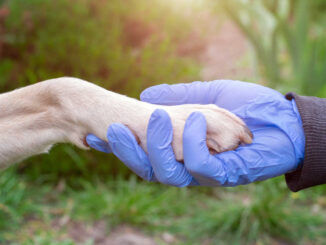

Be the first to comment